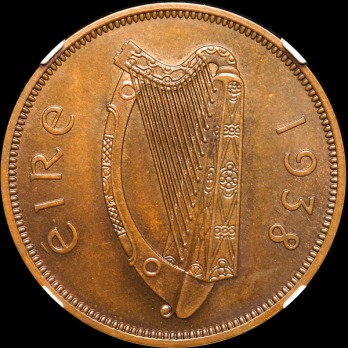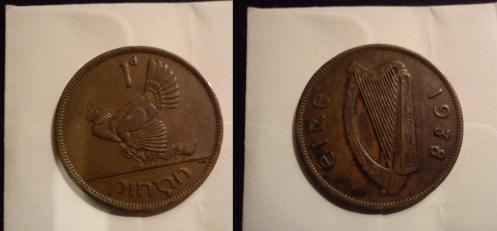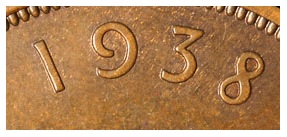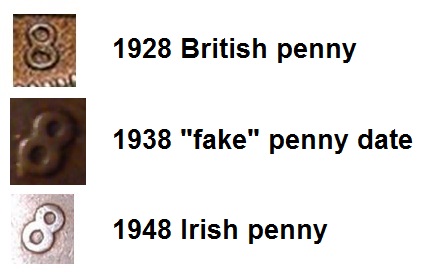In 1937, a new constitution declaring Ireland a free state was established and the old designs for the coins of Ireland that featured the legend “Saorstat Eireann” or Irish Free State were changed to “Eire” to reflect the new constitution.
The only known 1938 coins to feature that revised legend are:
- one halfcrown (currently unique and in the National Museum of Ireland)
- two pennies (one in the museum and one in private hands)
It is believed by some numismatic experts that these coins are “patterns” that were made to test the striking of the coins with the new legend. While the coin is not listed as a pattern in references, it features superior strike and surface quality relative to that of a normal business strike and, therefore, has been given a designation of Proof. The one example in private hands (the 1938 Irish Penny) has been designated as a “Specimen” by NGC to denote that it is a special striking.
Specimen is used to describe any coin produced to a particularly high standard of finish but nowadays, most people would describe them as ‘proof’ quality. Some mints produce especially good versions of their uncirculated coins which they call specimens – these are ordinary uncirculated coins which have been handled individually and with greater than normal care, to avoid most, but not all, of the surface blemishes which occur due to bulk handling. In that regard they would be very similar to brilliant uncirculated or FDC coins. In my considered opinion, the 1938 coin shown above falls well below that standard. If it was produced as a ‘test’ or ‘trial’ piece to see if the dies were suitable for future production or as a sample for the Central Bank of Ireland officials, it is a ‘pattern’ plain and simple.
Meanwhile, this debate is going to go on … and on … and on in finitum.
On Monday 10th July, 2000, the Irish Department of Finance presented a ‘trial striking’ of the modified dies for the 1938 Irish Penny and the 1938 Irish Halfcrown to the National Museum of Ireland.
These coins, dated 1938, were produced because the metal flow on these denominations between 1928 and 1937 was not particularly good leaving weak areas on the obverse harp. This would suggest that they were, in fact, patterns.
The 1938 penny and halfcrown ( discussed here ) are not really ‘circulating’ coins, i.e. they are patterns for the new designs to be introduced the following year.
As per my previous post (1933 British Penny), a ‘pattern’ or ‘trial’ is a coin which has not been approved for release, usually produced for the purpose of evaluating a proposed new or modified coin design. In my considered opinion, these coins are patterns – not specimens.
- Percy Metcalf, the designer of the 1928 coinage, used the opportunity of re-designing the obverse harp for all the coins to improve the reverses of these two denominations.
- These two examples were the coins supplied by Metcalf to the Department of Finance in November 1938. Since then they had remained secure but unknown in the department’s archives.
- It is possible that another 1938 halfcrown, or further 1938 pennies, will turn up as the contents of more archives are opened and examined in the near future when government departments are temporarily or permanently re-located.
With valuations ranging from €12,000 to as much as €35,000 for a single coin, it was inevitable that fakes would appear on the market.
In 2012 a fake Irish 1938 Irish penny appeared on Boards.ie and, from an enlarged image of the date, we can clearly see the “3” has been altered from another number. This example highlights the need for care when bidding or buying online, i.e. a clear image is vital before one makes a decision to bid or purchase.
Caveat emptor (Buyer beware)

The “3” in the date “1938” has clearly been altered, i.e. faked. This forgery has been produced to deceive the buyer. The “8” doesn’t look genuine either.
It has been suggested that the “3” has been grafted from another penny, so I show the date formats (fonts) from contemporary coins for comparison. See illustrations below.
Neither the ‘Saorstat’ penny or the later ‘Eire’ pennies look like good donor candidates, so it has been suggested that an earlier (George V) British penny looks like a good candidate … but the top half of the “3” on this coin is not a good fit.
- Perhaps the forger used the top half of an Irish penny “3” + the bottom half of a British penny “3”.
The “8” on the 1938 Irish penny forgery doesn’t look right either. Where did it come from?
It looks like it came from a 1948 Irish penny.
For a potential pay out of €12,000+, it might have been worth the time and effort to do this.
Caveat emptor (Buyer beware)
______________________________________________________
If you are interested in receiving our Monthly Irish Coin Pricelist, packed with our latest inventory of Irish Hammered, Pre-1928 Milled, Pre-Decimal and Decimal coins,
email us at old.currency.exchange@gmail.com
and mention that you are “want to receive the Monthly Irish Coins Pricelist”
______________________________________________________
- Do you collect Irish coins?
- If you would like to receive weekly blog posts on Irish coins …
- please share and LIKE this Facebook page https://lnkd.in/dPevTgs
If you found this article useful, please connect to me on LinkedIn and endorse some of my skills.
Alternatively, please connect or follow my coin and banknote image gallery on Pinterest.
Or, follow me on Twitter (I post daily)
Thank you
Now if you GENUINELY liked this post then it would be a HUGE help if you left a rating, or a review. It might seem insignificant, but it helps more than you might think.








Pingback: Coin Guide: Irish Pre-Decimal Penny | oldcurrencyexchange
O’Brien Coin Guide: GB & Ireland Bronze Pennies of George V
https://oldcurrencyexchange.com/2018/02/04/obrien-coin-guide-gb-ireland-bronze-pennies-of-george-v/
LikeLike
Great information about coins for anyone collecting or about to start collecting irish coins. Thanks very much for your help.
LikeLiked by 1 person
Great info it helps me learn more about worldly coins and hope i can learn more from you..
LikeLiked by 1 person